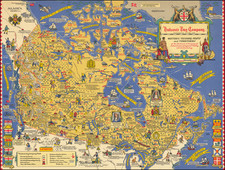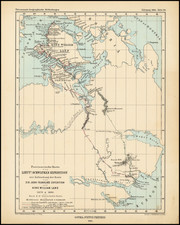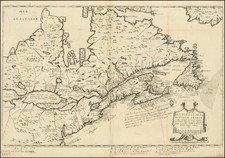Map of the North-West Rebellion of 1885.
Map of Saskatchewan , Assiniboyna, Manitoba and contiguous regions, illustrating the region impacted by the so-called North-West Insurrection (Rebellion) of 1885, pitting the indigenous Métis people against the Canadian Government.
After the Red River Rebellion of 1869-1870, many of the Métis moved from Manitoba to the Fort Carlton region of the Northwest Territories, where they founded the Southbranch settlements of Fish Creek, Batoche, St. Laurent, St. Louis, and Duck Lake on or near the South Saskatchewan River. In 1882, surveyors began dividing the land of the newly formed District of Saskatchewan in the square concession system. The Métis lands were laid out in the seigneurial system of strips reaching back from a river which the Métis were familiar with in their French-Canadian culture. A year after the survey the 36 families of the parish of St. Louis found that their land and village site that included a church and a school had been sold by the Government of Canada to the Prince Albert Colonization Company. The Métis feared losing their land which, now that the buffalo herds were gone, was their primary source of sustenance.
In 1884, the Métis (including the Anglo-Métis) asked Louis Riel to return from the United States, where he had fled after the Red River Rebellion, to appeal to the government on their behalf. In March 1885, Riel, Gabriel Dumont, Honoré Jackson (a.k.a. Will Jackson), and others, set up the Provisional Government of Saskatchewan, believing that they could influence the federal government in the same way as they had in 1869.
For Riel and the Métis, several factors had changed since the Red River Rebellion. The railway had been completed across the prairies in 1883, though sections were still under construction north of Lake Superior, making it easier for the government to get troops into the area. In addition, the North-West Mounted Police (NWMP) had been created, developing an armed local force. Riel lacked support from English settlers of the area as well as the great majority of tribes. Riel's claim that God had sent him back to Canada as a prophet caused Catholic officials (who saw it as heresy) to try to minimize his support. The Catholic priest, Albert Lacombe, worked to obtain assurances from Crowfoot that his Blackfoot warriors would not participate in a rebellion.
The Métis population in Saskatchewan in 1885 was about 5,400. A majority tried to stay neutral in the dispute with the national government, as the priests recommended. About 350 armed men supported Riel. A smaller number opposed him, led by Charles Nolin.
Riel had been invited in to lead the movement but he turned it into a military action with a heavily religious tone, thereby alienating the Catholic clergy, the whites, nearly all of the Indians, and most of the Métis. He had a force of a couple hundred Métis and a smaller number of Indians at Batoche, in May, 1885, confronting 8,000 government troops.
Commencing in March 1885, a number of armed conflicts occcured:
- Looting of Battleford: March 30, 1885.
- Frog Lake Massacre: April 2, 1885
- Battle of Fort Pitt: April 15, 1885
- Battle of Fish Creek: April 25, 1885
- Battle of Cut Knife: May 2, 1885
- Battle of Batoche: May 9, 1885
- Battle of Frenchman's Butte: May 28, 1885
- Battle of Loon Lake: June 3, 1885









![[The First Maps Printed Color] Cartes en Couleur des Lieux Sujets aux tremblements de Terre Dans toutes les parties du Monde Selon le Sisteme de l’impulsion Solaire](https://storage.googleapis.com/raremaps/img/small/52293op.jpg)


![Colton's Map of the United States The Canadas &c. Showing the Railroads, Canals, & Stage Roads With Distances From Place to Place…1856 [Pocket Map]](https://storage.googleapis.com/raremaps/img/small/85342.jpg)
![Carte Du Canada ou de la Nouvelle France et des Decouvertes qui y ont ete faites . . . [Map of Canada or New France and the Discoveries Made Therein . . .]](https://storage.googleapis.com/raremaps/img/small/94450.jpg)
